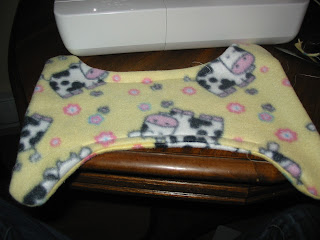So in my travels around the internet I have explained to a ton of new moms how to use prefold diapers with and without a diaper wrap, it's a little hard to explain without pictures so I decided to just make a blog post with step by step photos so next time the question comes up I can just link to here.
Please note there are several ways of using a prefold diaper I haven't included instructions on "doing the twist" because I just don't like doing it that way, I've never made it work right, if it works for you great, but for some reason I just can't get it to lay right and it looks uncomfortable.
Diaper fold and snappi - For use with a diaper wrap or pull on style cover, woolies or basic "rubber pants"
Step 1 - Find one cute baby who needs a new diaper
I found this one watching Mickey Mouse in my Living room, don't mind the bed head, it's early in the morning and she has curly hair.
Step 2 - lay out the diaper

You want the diaper back about level with baby's belly button
Step 3 - fold or roll in the loose edges

Fold or roll in the edges at and angle so the back is flat but the front is tapered.
Step 4 - pull diaper up between baby's legs

Bring the diaper up between baby's legs, folding down the front as needed for a proper fit. *note if you have a baby girl who tends to leak out the back of her diaper, fold down the excess at the back of the diaper before putting it under your baby in step 2, that will get you more absorbancy at the back to catch anything that would otherwise leak out.*
Step 5 - pin or snappi

Snappi is by far the easier way to go, and the only way I do it if at all possible. Fold the wings over to the front of the diaper and hook one side, then the other, and then pull down and hook the middle.
Add a cover and your all done.
Alternate (easy) Method
If you want to be quick and don't want to mess with pins or a snappi then you can simply trifold your prefold diaper and lay it in a diaper wrap. This method is more effective with older babies, if you do this with a newborn or EBF baby you will end up with poop on the cover amost of the time because there is nothing to contain it.

Here I have a basic PUL diaper wrap and an infant prefold
Basic Boy trifold
As we all know boys and girls need the absorbancy in different places. If you have a boy the best way to trifold is lengthwise so the majority of the absorbant layers run front to back.

First fold in one of the thin edges

Then fold in the other side.

Lay the folded diaper in the diaper wrap and your ready to go.

Some people like to tuck the front edge of the prefold under the flap in the cover, totally not nessasary, but if you want to go for it.
Basic Girl fold
If you have a baby girl you want more absorbancy in the middle so you just fold the prefold the opposite way

Fold bottom edge up about 2/3 of the way

Fold top edge down to meet the folded edge
 Pop it in the cover and your all done.
Pop it in the cover and your all done.

























 Pop it in the cover and your all done.
Pop it in the cover and your all done. 













